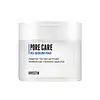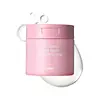What's inside
What's inside
 Key Ingredients
Key Ingredients

 Benefits
Benefits

 Concerns
Concerns

No concerns
 Ingredients Side-by-side
Ingredients Side-by-side

Water
Skin ConditioningButylene Glycol
HumectantGlycereth-26
Humectant1,2-Hexanediol
Skin ConditioningVitis Vinifera Fruit Extract
Skin ConditioningCarica Papaya Fruit Extract
Skin ConditioningPyrus Malus Fruit Extract
Skin ConditioningTerminalia Ferdinandiana Fruit Extract
AntioxidantBetula Platyphylla Japonica Juice
Skin ConditioningUlmus Davidiana Root Extract
Skin ConditioningSalvia Officinalis Leaf Extract
CleansingMelaleuca Alternifolia Leaf Extract
PerfumingMentha Citrata Leaf Extract
AstringentFicus Carica Fruit Extract
HumectantThuja Orientalis Leaf Extract
AntioxidantPhormium Tenax Leaf Powder
EmollientCharcoal Extract
Skin ConditioningPanthenol
Skin ConditioningHydroxyethyl Urea
HumectantCitric Acid
BufferingAllantoin
Skin ConditioningBetaine
HumectantEthylhexylglycerin
Skin ConditioningXanthan Gum
EmulsifyingOctyldodeceth-16
EmulsifyingDisodium EDTA
Sodium Citrate
BufferingWater, Butylene Glycol, Glycereth-26, 1,2-Hexanediol, Vitis Vinifera Fruit Extract, Carica Papaya Fruit Extract, Pyrus Malus Fruit Extract, Terminalia Ferdinandiana Fruit Extract, Betula Platyphylla Japonica Juice, Ulmus Davidiana Root Extract, Salvia Officinalis Leaf Extract, Melaleuca Alternifolia Leaf Extract, Mentha Citrata Leaf Extract, Ficus Carica Fruit Extract, Thuja Orientalis Leaf Extract, Phormium Tenax Leaf Powder, Charcoal Extract, Panthenol, Hydroxyethyl Urea, Citric Acid, Allantoin, Betaine, Ethylhexylglycerin, Xanthan Gum, Octyldodeceth-16, Disodium EDTA, Sodium Citrate
Beta Vulgaris Root Extract
Skin ConditioningWater
Skin ConditioningDipropylene Glycol
HumectantMethylpropanediol
SolventButylene Glycol
Humectant1,2-Hexanediol
Skin ConditioningTheobroma Cacao Seed Extract
AntioxidantGardenia Florida Fruit Extract
Skin ConditioningPanthenol
Skin ConditioningTrehalose
HumectantDisodium EDTA
Xanthan Gum
EmulsifyingTromethamine
BufferingGluconolactone
Skin ConditioningAllantoin
Skin ConditioningGlycolic Acid
BufferingDextrin
AbsorbentCyanocobalamin
Skin ConditioningSalicylic Acid
MaskingHydroxyacetophenone
AntioxidantBeta Vulgaris Root Extract, Water, Dipropylene Glycol, Methylpropanediol, Butylene Glycol, 1,2-Hexanediol, Theobroma Cacao Seed Extract, Gardenia Florida Fruit Extract, Panthenol, Trehalose, Disodium EDTA, Xanthan Gum, Tromethamine, Gluconolactone, Allantoin, Glycolic Acid, Dextrin, Cyanocobalamin, Salicylic Acid, Hydroxyacetophenone
 Reviews
Reviews

Ingredients Explained
These ingredients are found in both products.
Ingredients higher up in an ingredient list are typically present in a larger amount.
1,2-Hexanediol is a synthetic liquid and another multi-functional powerhouse.
It is a:
- Humectant, drawing moisture into the skin
- Emollient, helping to soften skin
- Solvent, dispersing and stabilizing formulas
- Preservative booster, enhancing the antimicrobial activity of other preservatives
Allantoin is a soothing ingredient known for its protective and moisturizingg properties. Because of this, it is often added to products with strong active ingredients.
Studies show higher concentrations of this ingredient can promote wound healing.
Though it can be derived from the comfrey plant, allantoin is produced synthetically for cosmetic products to ensure purity.
Learn more about AllantoinButylene Glycol (or BG) is used within cosmetic products for a few different reasons:
Overall, Butylene Glycol is a safe and well-rounded ingredient that works well with other ingredients.
Though this ingredient works well with most skin types, some people with sensitive skin may experience a reaction such as allergic rashes, closed comedones, or itchiness.
Learn more about Butylene GlycolDisodium EDTA plays a role in making products more stable by aiding other preservatives.
It is a chelating agent, meaning it neutralizes metal ions that may be found in a product.
Disodium EDTA is a salt of edetic acid and is found to be safe in cosmetic ingredients.
Learn more about Disodium EDTAPanthenol is a common ingredient that helps hydrate and soothe the skin. It is found naturally in our skin and hair.
There are two forms of panthenol: D and L.
D-panthenol is also known as dexpanthenol. Most cosmetics use dexpanthenol or a mixture of D and L-panthenol.
Panthenol is famous due to its ability to go deeper into the skin's layers. Using this ingredient has numerous pros (and no cons):
Like hyaluronic acid, panthenol is a humectant. Humectants are able to bind and hold large amounts of water to keep skin hydrated.
This ingredient works well for wound healing. It works by increasing tissue in the wound and helps close open wounds.
Once oxidized, panthenol converts to pantothenic acid. Panthothenic acid is found in all living cells.
This ingredient is also referred to as pro-vitamin B5.
Learn more about PanthenolWater. It's the most common cosmetic ingredient of all. You'll usually see it at the top of ingredient lists, meaning that it makes up the largest part of the product.
So why is it so popular? Water most often acts as a solvent - this means that it helps dissolve other ingredients into the formulation.
You'll also recognize water as that liquid we all need to stay alive. If you see this, drink a glass of water. Stay hydrated!
Learn more about WaterXanthan gum is used as a stabilizer and thickener within cosmetic products. It helps give products a sticky, thick feeling - preventing them from being too runny.
On the technical side of things, xanthan gum is a polysaccharide - a combination consisting of multiple sugar molecules bonded together.
Xanthan gum is a pretty common and great ingredient. It is a natural, non-toxic, non-irritating ingredient that is also commonly used in food products.
Learn more about Xanthan Gum